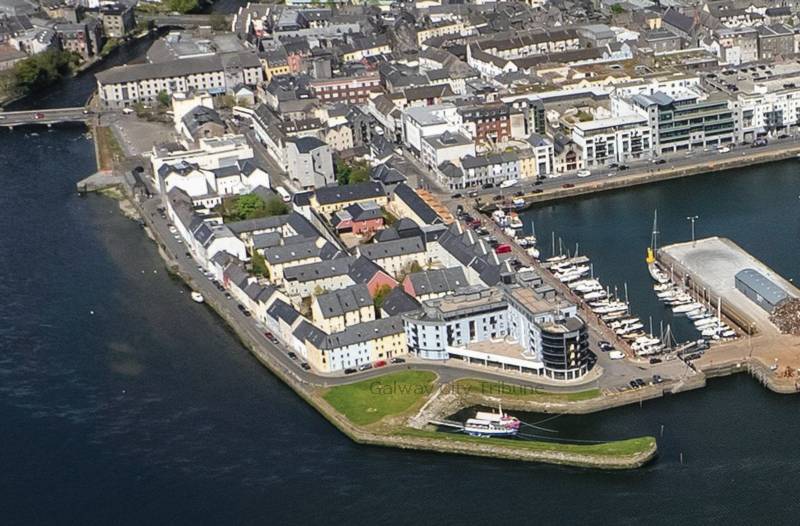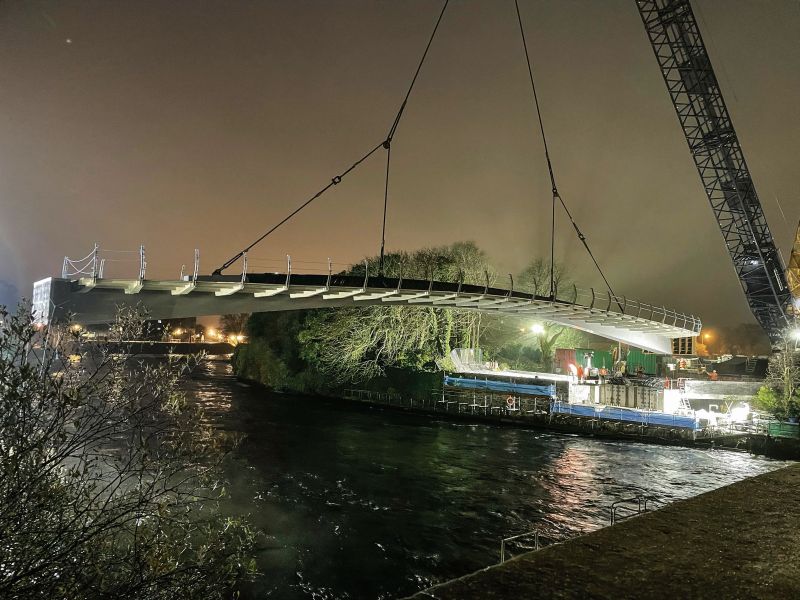CITY TRIBUNE
Plans lodged for €30m Connacht Rugby stadium

Connacht Rugby have lodged a planning application for the €30 million redevelopment of the Sportsground on College Road, which could be completed by early 2023.
The plans involve the construction of a 12,000-seater stadium with a new grandstand, high-performance training centre, 4G synthetic playing pitch, bars, food stands and supporter facilities.
If approved, the stadium would be developed over six phases, running from May 2019 to spring 2023, although it would be in a position to open in 2022.
Connacht Rugby Stadium Ltd – which is headed by Willie Ruane and Michael Turley – has sought permission to demolish the Clan Terrace and Connacht Rugby offices, training pitches, and ESB substation and to construct a new north grandstand.
The grandstand will have terraced and seating areas over four levels, and will also include bars and food stands, player and match day facilities, café, merchandise shop, TV facilities and a corporate seating and bar area.
The south stand will be completely refurbished, and a new high-performance centre with an indoor synthetic training pitch and office accommodation will replace the demolished clubhouse.
The existing grass pitch will be replaced with a synthetic 4G pitch, and the main access will be relocated with a new concourse adjacent to the new grandstand.
According to the application, the plans are intended to “modernise the campus and bring the facility in line with other Irish provincial teams and to provide a state-of-the-art training campus for the development of Connacht Rugby”.
The Sportsground can currently accommodate 6,204 people, or 7,924 when increased capacity plans are in place. The new stadium will hold 10,600 people on a typical match day, although additional capacity will mean a total of 12,000 could be accommodated.
“A key ambition for the redevelopment of the Sportsground was to physically and visually connect the ground and associated facilities to Galway. This is to make the most of the real asset of having a city centre location and the sense of place and the ownership that it brings,” the application reads.
Independent economic research carried out in 2016, found that Connacht Rugby contributes €34.4 million to the regional economy.
Connacht Rugby CEO Willie Ruane said: “The delivery of this project will increase that contribution and provide a beacon for regional development in the West of Ireland. Our vision is to ensure that the province has a stadium which future generations of sports stars, supporters and all the people of the West of Ireland can be immensely proud of.”
A decision on the planning application is due in February, although the City Council may at that point request revisions to be made to the plans, or seek clarification on certain elements.
How the works will progress:
Phase 1 of the works involves the upgrading of the existing main pitch, and work will take place between May and August 2019.
Phase 2 will see the construction of the high-performance training centre, which will begin in the second quarter of 2020 and take 12 months to complete.
Phase 3 involves the demolition of the existing buildings and training pitch, clubhouse, bar etc. This will commence in Q2 of 2021 and take three months.
Phase 4 will commence in Q3 2021 and will take 16 months to complete. It involves the construction of the new northern grandstand and concourse.
Phase 5 involves the demolition of structures including temporary stands and terracing. This will commence in Q3 of 2022 and take one month.
The final phase involves work on the existing southern (Irish Greyhound Board) stand and will take six months from Q3 2022.
CITY TRIBUNE
Galway ‘masterplan’ needed to tackle housing and transport crises

From the Galway City Tribune – An impassioned plea for a ‘masterplan’ that would guide Galway City into the future has been made in the Dáil. Galway West TD Catherine Connolly stated this week that there needed to be an all-inclusive approach with “vision and leadership” in order to build a sustainable city.
Deputy Connolly spoke at length at the crisis surrounding traffic and housing in Galway city and said that not all of the blame could be laid at the door of the local authority.
She said that her preference would be the provision of light rail as the main form of public transport, but that this would have to be driven by the government.
“I sat on the local council for 17 years and despaired at all of the solutions going down one road, metaphorically and literally. In 2005 we put Park & Ride into the development plan, but that has not been rolled out. A 2016 transport strategy was outdated at the time and still has not been updated.
“Due to the housing crisis in the city, a task force was set up in 2019. Not a single report or analysis has been published on the cause of the crisis,” added Deputy Connolly.
She then referred to a report from the Land Development Agency (LDA) that identified lands suitable for the provision of housing. But she said that two-thirds of these had significant problems and a large portion was in Merlin Park University Hospital which, she said, would never have housing built on it.
In response, Minister Simon Harris spoke of the continuing job investment in the city and also in higher education, which is his portfolio.
But turning his attention to traffic congestion, he accepted that there were “real issues” when it came to transport, mobility and accessibility around Galway.
“We share the view that we need a Park & Ride facility and I understand there are also Bus Connects plans.
“I also suggest that the City Council reflect on her comments. I am proud to be in a Government that is providing unparalleled levels of investment to local authorities and unparalleled opportunities for local authorities to draw down,” he said.
Then Minister Harris referred to the controversial Galway City Outer Ring Road which he said was “struck down by An Bord Pleanála”, despite a lot of energy having been put into that project.
However, Deputy Connolly picked up on this and pointed out that An Bord Pleanála did not say ‘No’ to the ring road.
“The High Court said ‘No’ to the ring road because An Bord Pleanála acknowledged it failed utterly to consider climate change and our climate change obligations.
“That tells us something about An Bord Pleanála and the management that submitted such a plan.”
In the end, Minister Harris agreed that there needed to be a masterplan for Galway City.
“I suggest it is for the local authority to come up with a vision and then work with the Government to try to fund and implement that.”
CITY TRIBUNE
Official opening of Galway’s new pedestrian and cycle bridge

The new Salmon Weir pedestrian and cycle bridge will be officially opened to the public next Friday, May 26.
Work on the €10 million bridge got underway in April 2022, before the main structure was hoisted into place in early December.
A lunchtime tape-cutting ceremony will take place on Friday, as the first pedestrians and cyclists traverse the as-yet-unnamed bridge.
The Chief Executive of Galway City Council, Brendan McGrath, previously said the bridge, once opened, would remove existing conflicts between pedestrians, cyclists and traffic “as well as facilitating the Cross-City Link public transport corridor over the existing 200-year-old bridge”.
The naming of the new bridge has been under discussion by the Council’s Civic Commemorations Committee since late last year.
One name that has been in the mix for some time is that of the first woman in Europe to graduate with an engineering degree – Alice Perry.
Ms Perry, who was from Wellpark, graduated from Queen’s College Galway (now University of Galway) in 1906. The university’s engineering building is named in her honour.
The bridge was built by Jons Civil Engineering firm in County Meath and was assembled off-site before being transported to Galway. Funding for the project was provided in full by the National Transport Authority and the European Regional Development Fund.
(Photo: Sheila Gallagher captured the city’s new pedestrian footbridge being raised on the south side of the Salmon Weir Bridge in December. It will officially open next Friday, May 26).
CITY TRIBUNE
Minister branded ‘a disgrace’ for reversing land rezoning in Galway City

From the Galway City Tribune – Minister of State for Local Government and Planning, Kieran O’Donnell was labelled a “disgrace” for overturning councillors’ decisions to rezone land in the new City Development Plan.
Minister O’Donnell (pictured) confirmed in a letter to Council Chief Executive Brendan McGrath last week that he was reversing 25 material alternations made by councillors to the CDP 2023-29. He made the decision on the advice of Office of Planning Regulator (OPR).
Minister O’Donnell directed that 14 land parcels that were subject to land-use zoning changes by councillors as part of the Material Alterations to the Draft CDP should be reversed.
He directed that a further 11 land parcels in the city should become “unzoned”.
The Minister found that the CDP had not been made in a manner consistent with recommendations of the OPR, which required specific changes to the plan to ensure consistency with the national planning laws and guidelines.
At last week’s Council meeting Cllr Eddie Hoare (FG) asked for clarity on the process by which councillors could rezone the lands that had been changed by the Minister’s direction.
Cllr Declan McDonnell said, “What he [Minister O’Donnell] has done is an absolute disgrace”.
And he asked: “Do we have to have another development plan meeting to deal with it?”
Both Cllrs Hoare and McDonnell wondered what would become of the lands that were rezoned or unzoned by the ministerial direction.
Mr McGrath said the Council had put forward an argument in favour of retaining the material alterations in the plan, but ultimately the Minister sided with OPR.
He said if councillors want to make alterations to the new plan, they could go through the process of making a material alteration but this was lengthy.
The Save Roscam Peninsula campaign welcomed the Minister’s decision.
In a statement to the Galway City Tribune, it said the direction would mean the Roscam village area on the Roscam Peninsula will be unzoned and a number of land parcels would revert back to agriculture/high amenity.
A spokesperson for the campaign said: “the material alterations made by city councillors following lobbying by developers continued the long-standing practice of councillors facilitating a developer-led plan rather than an evidence- and policy-based plan that meets the needs of the city.
“The Minister’s direction is an important step in restoring confidence in the planning system. It is clear from the City Council’s own evidence on future housing projections that there was no requirement to zone these lands for residential purposes in order to meet the needs of the targeted population increase up to 2029,” the spokesperson added.












